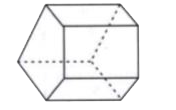How many number of energy bands are there in solids ?
The correct Answer is:Three, conduction, valence, Eorbidden
Topper's Solved these Questions
Similar Questions
Read the following passage and then answer question (a) - (e) on the basis of your understanding of the following passage and the related studied concepts.
As per Bohr atom model, in an isolated atom the energy of any of its electrons depends on the orbit in which it revolves and it is characterised by a sharp energy level. However, inside a crystalline solid atoms are close to each other and the outer orbits of electrons from neighbouring atoms would come very close or could even overlap. As a result, each electron will have a different energy level. These different energy levels with continuous energy variation form energy bands.
The energy band which includes the energy levels of the valence electrons is called the valence band. All the valence electrons reside in the valence band. The energy band above the valence band is called the conduction band. Normally the conduction band is empty.
If the lowest level in the conduction band happens to be lower than the highest level of the valence band, electrons from the valence band may easily move into the conduction band and the solid behaves as a conductor.
If there is some gap between the conduction band and the valence band, electrons in the valence band remain confined to it and no free electrons are available in the conduction band. It makes the solid an insulator.
If some of the electrons from the valence band may gain external energy to cross the gap between the conduction band and valence band, these electrons will move into the conduction band and simultaneously create vacant energy levels in the valence band. Therefore, there is a possibility of conduction due to electrons in conduction band as well as due to vacancies in the valence band.
How are energy bands formed in a crystalline solid ?
View SolutionEnergy Band Theory Of Solids
View Solution
Knowledge Check
Solids having highest energy level partially filled with electrons are
AAn insulatorBA conductorCA semiconductorDNone of theseThe manifestation of band structure in solids is due to
ABohr's correspondence principleBpauli's exclusion principleCHeisenberg's encerainly principleDBoltzmann's law
Explain formation of energy band in solids. Distinguish between conductors, extrinsic and intrinsic semi-conductors and insulators on the basis of band theory.
View SolutionHow many cubes are needed to make the solid below?
View SolutionExpalin the formation of energy band in solids. Draw energy band diagram for (i) and conductor (ii) and intrinsic semiconductor.
View SolutionDraw a labelled energy band diagram for a solid which is an insulator. What is the main difference between this diagram and that of a semiconductor?
View SolutionHow many faces does the given solid have ?

View SolutionExplain formation of energy band in solids. Distinguish between conductors, extrinsic and intrinsic semi-conductors and insulators on the basis of band theory.
View Solution
